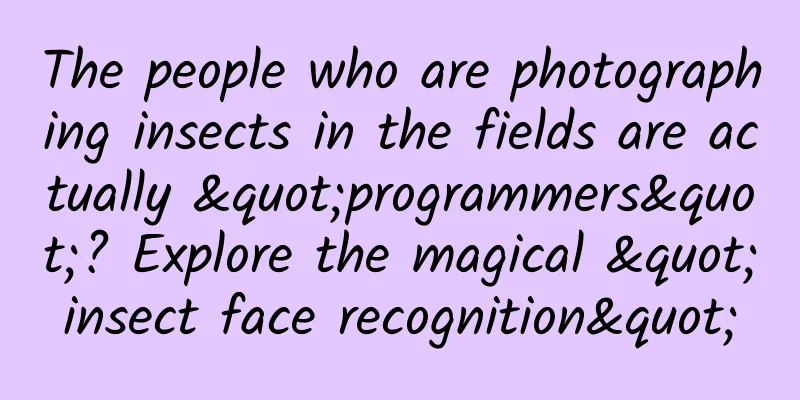The people who are photographing insects in the fields are actually "programmers"? Explore the magical "insect face recognition"

|
In our previous article "Pests: How can eating expose your ID number?", we introduced the principle of "insect face recognition". In this article, we will continue to explore the mystery of "insect face recognition", find out the interesting stories of scientists, and interpret more interesting "black technology" for you. The people swatting insects in the fields are actually “programmers”? There is a group of "programmers" who don't type code in front of computers, but shoot insects in the fields and study the morphology of these insects every day. Why do they do that? You should have guessed it, they are scientists studying "insect face recognition". Almost all of these people are experts in artificial intelligence. When they first started studying this technology, due to the lack of experimental data, they would go into the rice fields, wearing straw hats, long sleeves, long pants and rain boots, and concentrate on taking pictures. This shooting lasted for three years. They plunged into the fields, working in the fields in the biting cold in winter and the scorching sun in summer. Scientists collect data in the field (Image source: author) It was not until the last year, when the amount of data was sufficient, that scientists began to conduct large-scale data analysis, organization, and research and development of algorithms and models. In just one year, they produced a large number of high-quality academic results. After so many years, their efforts finally paid off. I am a member of this team. From face recognition to "insect face recognition", my choice stems from my interest in the field of intelligent identification of pests and diseases, and more importantly, from my mission to use technology to contribute to agriculture and even society. The intelligence of my country's secondary and tertiary industries has reached a very high level, but as a major agricultural country, my country's intelligence and information level in the primary industry is still at a very early stage. It is the responsibility of scientific researchers to develop technologies such as "insect face recognition" to help the intelligent construction of the primary industry. Listen to me and say thank you, because of you, all the pests are exposed The "bug face recognition" technology can serve a wide range of people. The first are farmers and large grain growers. Because they farm all year round, they can identify some pests, but the types they can identify are very limited. "Insect face recognition" technology can help them identify unknown pests, tell them when pests may occur, and under what circumstances they need to be controlled. In this way, they can apply pesticides in a timely and accurate manner, avoiding delays in the best time to use pesticides or blind use of pesticides, which is of great benefit to ensuring food security and protecting the soil. The second is plant protection experts. Plant protection experts are a team of professionals who periodically survey the fields under their jurisdiction, report whether there are serious diseases and pests in the crops in the current area, whether there are migratory pests that may cause infection, and timely evaluate the situation of crops in the current jurisdiction and issue early warnings to the surrounding areas. At present, field monitoring and reporting work is mainly done by them in person in the fields. The number of field professionals in our country is extremely scarce compared to the vast planting area , so this is a job with extremely high labor costs and extremely low efficiency. The "insect face recognition" technology can improve the efficiency of field surveys of pests and diseases by plant protection personnel, allowing them to quickly obtain information on field pests and diseases, so as to quickly infer the scale and level of pests and diseases, and thus make reasonable and overall judgments. Professionals are collecting pest information (Image source: author) The occurrence of pests and diseases is related to the solar terms and climate. Each pest occurs at different times . For example, some pests may only occur in May and June on wheat, while some may only occur in July and August. Therefore, the investigation of field pests and diseases runs through the entire growth of crops. From the moment the crops are sown, the field investigation work must begin until the harvest is over. Weather is an important factor that causes pests. Frequent rain may cause pests, drought may lead to fewer pests, and migratory pests may appear on typhoon days... What needs more attention for diseases is the growth cycle of crops, because diseases generally occur in certain key cycles. During this window period, it is necessary to understand the extent of the disease to determine whether prevention and control are necessary. Plant protection experts will use "insect face recognition" technology to give specific suggestions. The current main application of "insect face recognition" technology is in Anhui Province. Since 2016, the National Agricultural Extension Center and the Anhui Provincial Plant Protection Station have promoted and applied it to four provinces and cities across the country, and in 2018 it was expanded to six provinces and cities (Anhui Province, Jiangxi Province, Henan Province, Hunan Province, Hubei Province, and Shandong Province). Therefore, this is an artificial intelligence technology that benefits the whole country. The fortune-telling of immortals cannot be trusted, and the "machine calculation worm" is coming soon We are still working on predicting pests, and we will get better at it in the future. The Institute of Intelligent Machinery of the Hefei Institutes of Physical Science, Chinese Academy of Sciences, has cooperated with other institutions to develop detection and warning devices. The most successful case is the fixed pest detection and warning lamp in the field. It is equivalent to placing a light-attracting lamp in the field. After the pests are lured with light, the captured pests are automatically photographed periodically, and the images are identified using artificial intelligence technology to remotely confirm the type and number of pests. The recognition rate of key pests of the detection and warning lamp can reach 75%~80%, and it may reach 90% for very important pests. Pests under the detection lamp (Photo source: author) In addition to this type of immediate prediction, scientists are working towards longer-term predictions. Perhaps now manual work is required to collect samples in the field, use mathematical regression algorithms to build models for calculation, and manually supplement and maintain the models. In the future, this will be done through unmanned equipment or more intelligent auxiliary equipment. At that time, using advanced artificial intelligence technology, it will be possible to achieve automated rapid iteration of pest occurrence prediction models, helping scientists predict pests and diseases faster and more accurately. I believe that in the near future, artificial intelligence will be able to make real medium- and short-term predictions of field pests or diseases based on the data that has been identified, and issue disaster warnings in advance for pests that may appear tomorrow or the day after tomorrow or next week, to better serve farmers in preparing in advance, protect agricultural crops from pests and diseases, and take the food safety of agricultural products to a higher level. “Black technology” is here, no more “sweating under the soil”! The Institute of Intelligent Machinery of the Hefei Institutes of Physical Science, Chinese Academy of Sciences, has achieved full coverage of "black technology" on the topic of smart agriculture. In terms of information collection, the overall agricultural information collection is carried out through the coordination of air, sky and ground. Technologies such as "insect face recognition" are biased towards the "ground", while in the "air", the current technology can already use the multi-spectral space to monitor the seedlings in the field, and judge the current growth of crops, growth period and the growth of surrounding weeds. In the "sky", it is mainly remote sensing of meteorology and large-scale judgment of the overall crop growth. In terms of soil testing, previous soil testing required manual digging and sending the soil to a testing center. It would take a week to test the organic matter and harmful heavy metal content in the soil, and guide farmers on how to apply fertilizer based on the test results. There are already some relatively mature equipment, such as fast high-throughput soil testing robots, which can completely simulate human testing movements, achieve simultaneous testing of dozens of samples, and improve testing efficiency . In addition, there are also rapid testing equipment that can quickly check the content of key components in the soil by collecting some soil in the field. Both technologies serve the majority of farmers, can greatly reduce the cost of soil testing, and provide an important reference for precision fertilization. Soil testing robot (Image source: Official website of the Institute of Intelligent Machinery, Hefei Institutes of Physical Science, Chinese Academy of Sciences) In the later stage of work, a research group is also doing research on pesticide residue detection. Through a test paper, it can be known in just a few minutes whether there are excessive pesticide residues in this batch of fruits and vegetables, which can provide safer food guarantee for the entire market at the production end. Conclusion From "insect face recognition" to all-round smart agriculture, scientists have worked hard in the fields, overcome difficulties one by one with an indomitable scientific spirit, and contributed scientific and technological strength to farmers, agriculture and even society. I believe that in the near future, scientists will introduce more "black technologies" with more functions for us, so let us wait and see! Author: Du Jianming This article is from the "Science Academy" public account. Please indicate the source of the public account when reprinting. |
Recommend
A look at the logic of Xiaohongshu's homepage recommendation algorithm from the perspective of popular notes
As an operator, I have always been paying attenti...
A person born in the 1980s died of a sudden heart attack. Heart attacks are happening at younger and younger ages. How can you be sure that you are not on the "surprise list" of heart attacks?
Lu Yang, general manager of Shanghai Botong Inves...
This fish is the best for hot pot, because it is "sick"! But there is a type of people who should never eat it...
In Guangdong, there is a very special delicacy. I...
How do public accounts make money? Monthly income of 5000+, simple and crude way to make money
From the transformation to the new media matrix h...
Super cool! 10 km vertical take-off and landing return flight, my country's reusable rocket has made a new breakthrough!
At noon on September 11, China's independentl...
People are celebrating my festival, and I'm in chains
Today's push is quite special Please rotate y...
Ancient encryption technology
See how we've hidden private information thro...
WeChat short video: How to bloom brilliantly after a short-lived bloom?
At the end of September, WeChat officially launch...
up to date! Data rankings of 60 information flow advertising platforms!
Today I bring you the latest traffic rankings of ...
Introduction to the latest review standards for the promotion of the financial industry in the Meizu App Store!
The latest review standards for financial industr...
Four major marketing details of APP make your APP unique
Abstract : 1. Focus on user experience. Today'...
State Administration for Market Regulation: Tesla recalls some imported Model S series vehicles
Recently, Tesla Motors (Beijing) Co., Ltd. filed ...
What are the consequences if Pinduoduo’s main category is wrong? How many categories can you focus on?
When opening a Pinduoduo store, you list your pro...
Tiangong celebrates the New Year in space! Questions about space dumplings
Tomorrow is the Chinese New Year, and Chinese ast...
Why is marijuana banned?
Marijuana is listed as one of the world's thr...









